#upper susa valley
Text

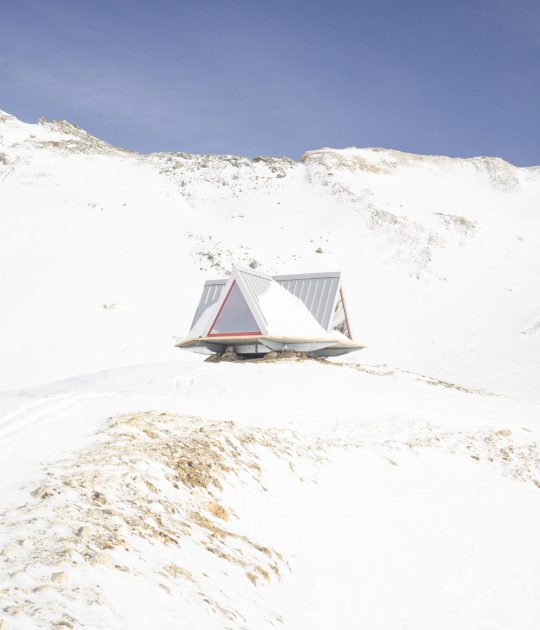



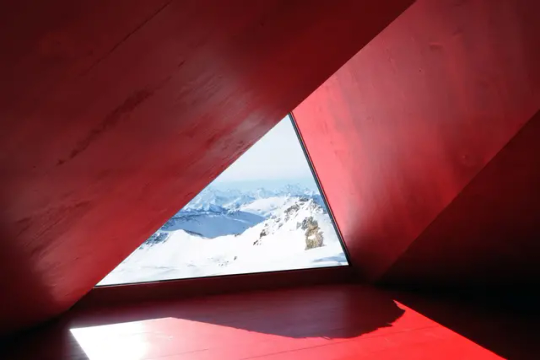
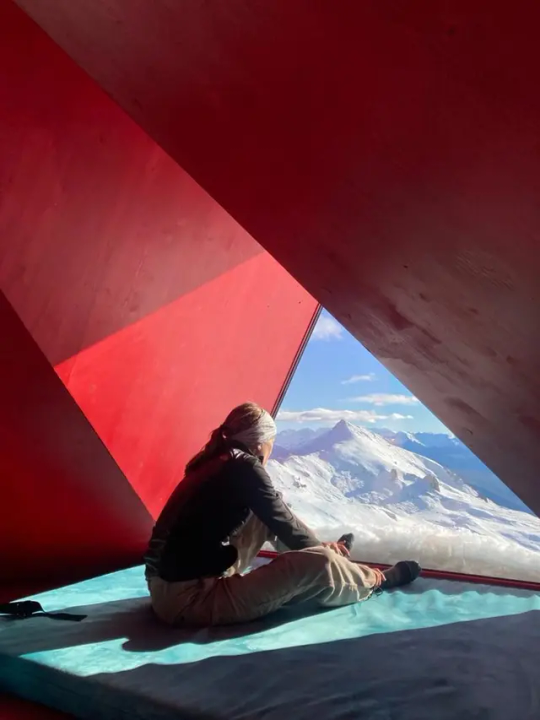
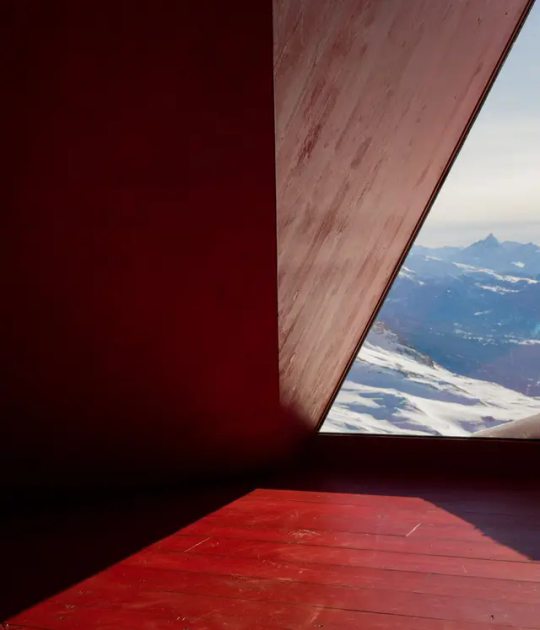
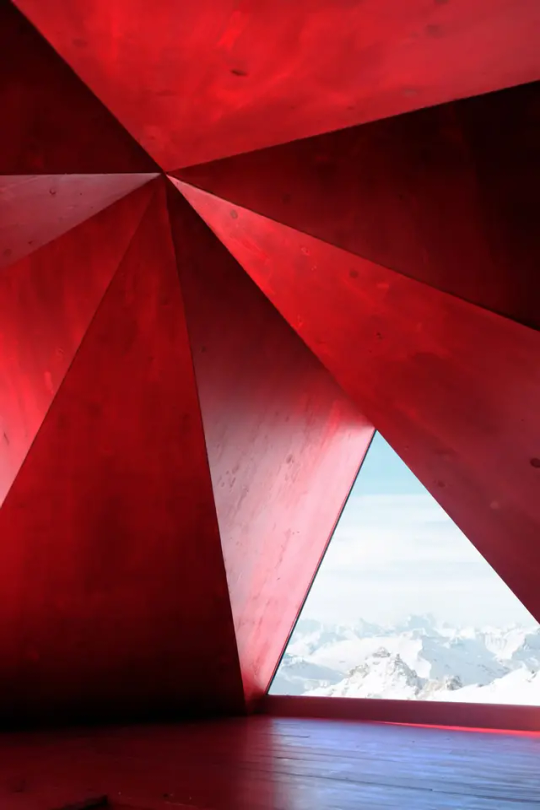
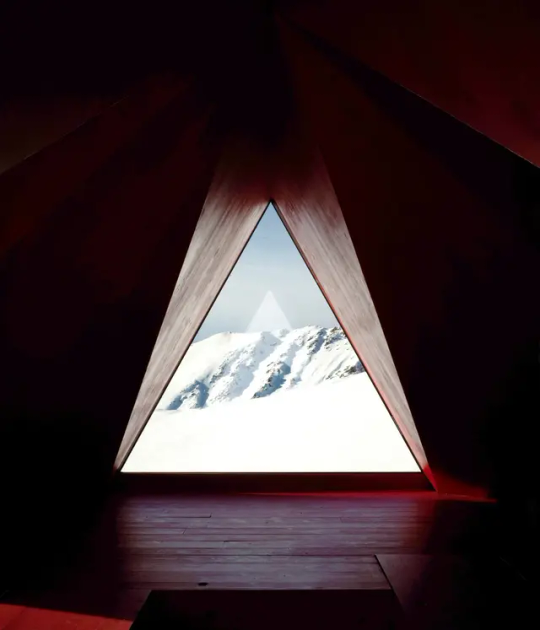
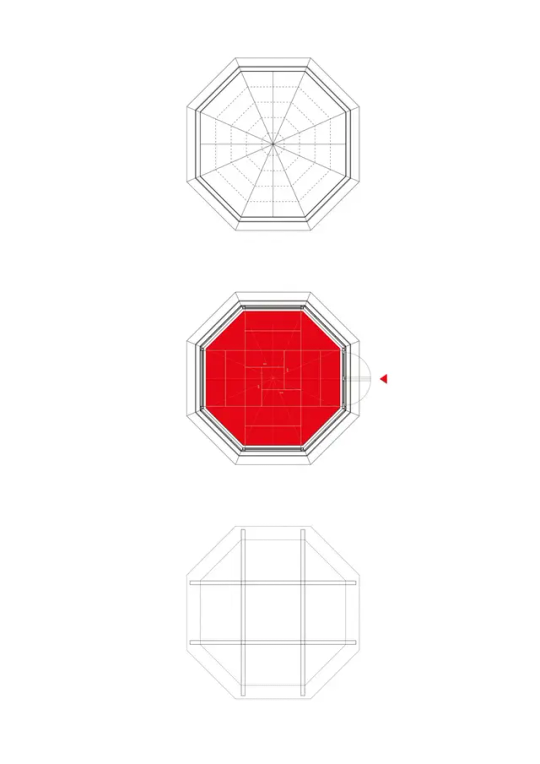


Pinwheel Shelter, Upper Susa Valley, Italy,
Perched 2,850 meters above sea level, the Pinwheel Shelter represents a remarkable fusion of architectural innovation and a heartfelt tribute to the late alpinist Stefano Berrone.
This mountain refuge employs prefabricated Cross-Laminated Timber (CLT) panels and aluminium cladding to achieve both aesthetic elegance and environmental sensitivity.
Inside, the design is both functional and symbolic, with a central fireplace and sleeping areas arranged around it, reminiscent of traditional Japanese tatami mat proportions. T
By providing a safe haven for climbers and hikers in a region prone to sudden meteorological changes, the shelter serves a vital function while celebrating Berrone's legacy.
Designed by architecture studio EX
#art#design#architecture#minimal#interior design#minimalism#nature#shelter#hiking#pinwheel#italy#upper susa valley#stefano berrone#EX#alps#italien alps#climbing#CLT#aluminium#prefab#prefabricated buildings#tent
82 notes
·
View notes
Text
2 Lifeless In Avalanche Close To Revelstoke, B C Ctv Information
The Mountaineering collection locations a excessive worth on an unrestricting match, heat, and enough sturdiness to handle the calls for of an extended alpine objective. PAR999 Holdings Inc. will build a luxurious resort in Hinton, Alta. which may also function a hospitality schooling centre, and is planning to interrupt floor in 2023. Great Canadian Heli-Skiing in Canada is exploring potential development alternatives. The Porter family has exclusively retained CBRE Limited to discover strategic financing and partnership options for the future enlargement and progress alternatives of its enterprise. I don’t ski anymore however this makes me wish I could give it a strive.
Whistler is the perfect place to expertise heli-skiing or heli-snowboarding. Featuring final vertical, sky high views, a thrilling helicopter ride and probably the most journey you possibly can pack right into a day, a heli-skiing or boarding tour would be the spotlight of your trip. 90% of heli-skiing in the world happens in British Columbia and the heli-skiing area around Whistler is greater than 50 occasions the size of the Whistler Blackcomb ski space. The extent of the terrain means there's variety and fantastic circumstances for all climate and snow varieties.
And, if the prospect of skiing beneath the stars intrigues you, Kimberley Alpine Resort has considered one of North America’s longest illuminated runs. Perfect for households, the mountain presents every thing from wide-open groomed runs, powder stashes, adventurous steeps and beautiful views in a friendly, downhome ambiance. There’s lots of apres ski on the Stemwinder Bar and Buckhorn & Main Restaurant. Discover more at the Kimberley Alpine Resort – explore with a backcountry journey with Boulder Hut Adventures.
In Whistler, you might also benefit from the comfort of staying in-resort while accessing the wilderness. Choose from all kinds of accommodation, and benefit from the dining, purchasing and other winter actions on offer. Whether you're a first-time heli-skier or a seasoned CMH visitor, CMH Purcell provides a number Heli skiing Canada of methods to satisfy your powder appetite. All-inclusive heliskiing stay in the upper Susa valley which, due to its central location, undoubtedly benefits from probably the greatest snow-capped areas within the Alps. We have listed greater than eighty completely different descents within the 5 heliskiing sectors of the valley.
Coté started flying helicopters in his early 20s, but – like Doty – he didn’t get into heli-ski piloting for a while. He’s lived and labored in Revelstoke as pilot since 1995 however didn’t begin working as a heli-ski pilot until the last 20 years. You’re attempting to wind up as high as you can within the whitest situations possible. Most of the time it’s windy, and the higher up you go the helicopter’s performance decreases.
▪ Able to communicate in an efficient and timely manner, and overtly receive and act on feedback. ▪ Willingness to help Heli skiing Canada other members of the lodge staff, as needed. ▪ Perform radio responsibility, as required, to assist subject operations.
However, after gradual exposure to the world of competitive ski racing, she fell into a rhythm of training with the Smithers Ski Club. Claire developed abilities that took her to race all over the world and finally led to a diverse ski career of teaching, motion modelling, writing, and work in the media trade. She has been featured on numerous journal Heli skiing Canada covers and advertising campaigns as properly as in movement as a number for Ski TV. Her Ski Fit applications have also been published in print and online. Though Claire likes to travel and ski new places, there'll all the time be a particular place in her coronary heart for the mountain where it all began.
0 notes
Photo

Canon EOS 250D | 135mm | 1/640s | f/6.3 | ISO 100 Taken on 20/02/2021. The Fortress of Fenestrelle is the longest military fortification in Europe and the largest single military construction after the Great Wall of China. Situated in the upper Chisone valley, this virtually impregnable fortification was commissioned by the Savoyard King Vittorio Amedeo in the 1720s, and designed and constructed by the engineers Antonio and Ignazio Bertola. Used by both Napoleon and the Savoyards as a maximum security gaol, the Fortress was feared for the harshness of its conditions. In fact, during the 19th century, many important figures were confined in the Fortress, the most famous being Cardinal Pacca, Secretary to Pope Pius VII. It's worth visiting this Fortress—whether or not you wish to climb the 4000 steps to the very top! 𝗛𝗼𝘄 𝘁𝗼 𝗴𝗲𝘁 𝘁𝗵𝗲𝗿𝗲: You can get to Fenestrelle by bus from Torino Porta Susa station or Pinerolo with 'SADEM' (line 275). ______________________________________ #ValChisone #Ig_Turin #IgersTorino #Italia #Italy #Fenestrelle #BestInTravel #BestPiemontePics #BeautifulPlaces #ItaliaSegreta #ItalyInspired #ClickFor_Italia #Piemonte_Illife #LandscapePhotography #WhatItalyIs #Italia_BestPhoto #Super_Italia_Channel #Map_Of_Italy #Don_In_Italy #Awesome_Shots #TravelItaly #Ig_Piemonte #PassionPassport #Socality #Total_Italy #FramesOfItaly #DoYouTravel #EarthOutdoors #ShotzDelight #BeyondTheLands (at Fenestrelle) https://www.instagram.com/p/CMj6p0NlNdz/?igshid=nagygyfuets0
#valchisone#ig_turin#igerstorino#italia#italy#fenestrelle#bestintravel#bestpiemontepics#beautifulplaces#italiasegreta#italyinspired#clickfor_italia#piemonte_illife#landscapephotography#whatitalyis#italia_bestphoto#super_italia_channel#map_of_italy#don_in_italy#awesome_shots#travelitaly#ig_piemonte#passionpassport#socality#total_italy#framesofitaly#doyoutravel#earthoutdoors#shotzdelight#beyondthelands
0 notes
Photo
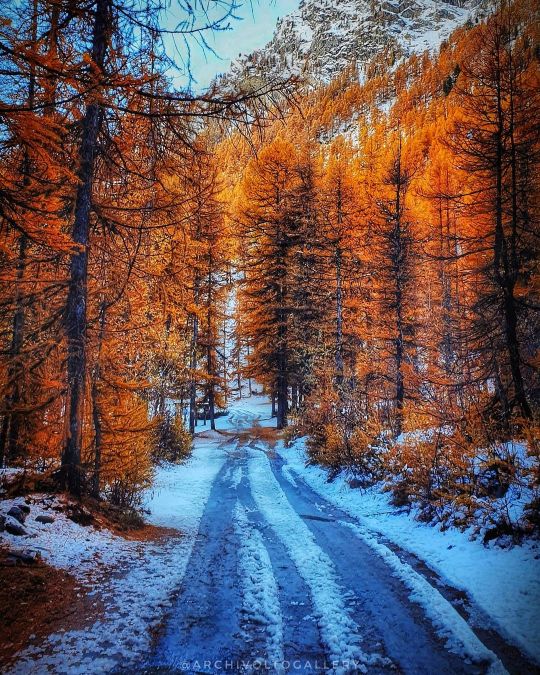
🐤 🇬🇧 Another unforgettable outing in the Argentera valley. Upper Susa valley. Welcome autumn 🍁🍂 〰️〰️〰️〰️〰️〰️〰️〰️〰️〰️〰️〰️〰️〰️ 📱 Made by Samsung S10+ 👉 Follow: @archivoltogallery 🙏 Tag a friend ! 🇮🇹 Visit Susa Valleys ! 〰️〰️〰️〰️〰️〰️〰️〰️〰️〰️〰️〰️〰️〰️ Susa is at 30 minuts from everywhere in Susa Valley and Archivolto B&B can be your base camp for your adventures or your home away from home! 🏠👍 👉Link in bio👈 .. 〰️〰️〰️〰️〰️〰️〰️〰️〰️〰️〰️〰️〰️〰️ #archivoltogallery #iloveautumn #valsusa #pittoresque #autunno🍁 #foglie #coloridautunno #valleargentera #autumnvibes #loves_united_piemonte #instanatura #outdoortones #kings_hdr #mtb #creativeoptic #piemonteconte #leaves🍁 #redleaves #great_captures_hdr #piemonte_super_pics #yallerspiemonte #ig_streets #piemonte #volgopiemonte #bestpiemontepics #volgopiemonte #igerspiemonte #ig_piemonte #total_hdr #fatalframes (presso Valle Argentera - Cesana) https://www.instagram.com/p/CHBsGCsMzvO/?igshid=5boy95lo4a20
#archivoltogallery#iloveautumn#valsusa#pittoresque#autunno🍁#foglie#coloridautunno#valleargentera#autumnvibes#loves_united_piemonte#instanatura#outdoortones#kings_hdr#mtb#creativeoptic#piemonteconte#leaves🍁#redleaves#great_captures_hdr#piemonte_super_pics#yallerspiemonte#ig_streets#piemonte#volgopiemonte#bestpiemontepics#igerspiemonte#ig_piemonte#total_hdr#fatalframes
0 notes
Photo
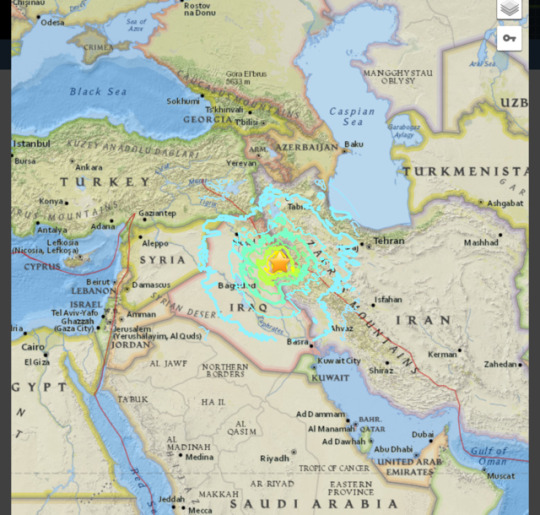
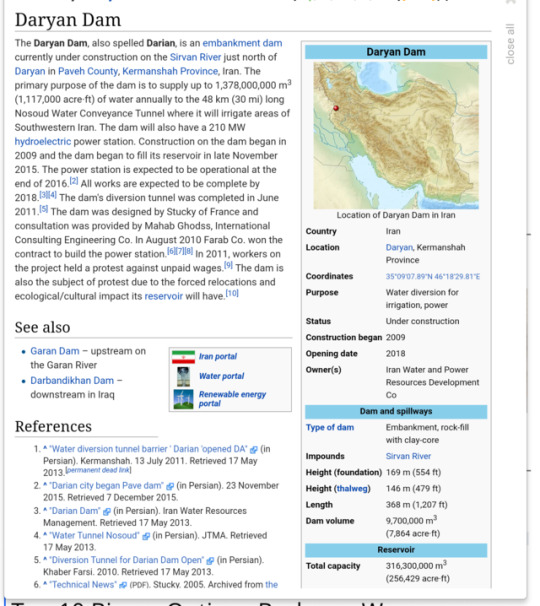

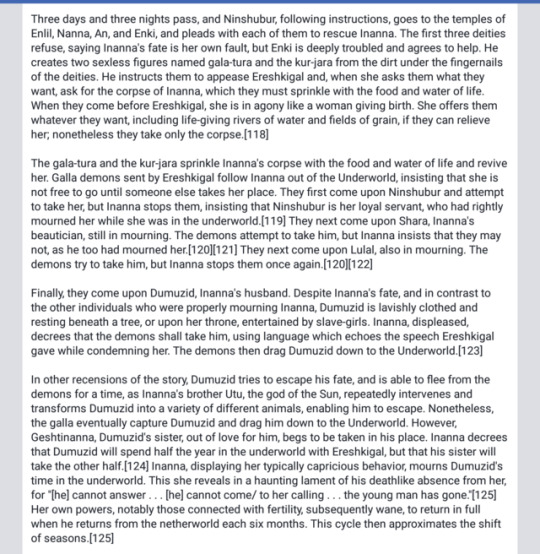


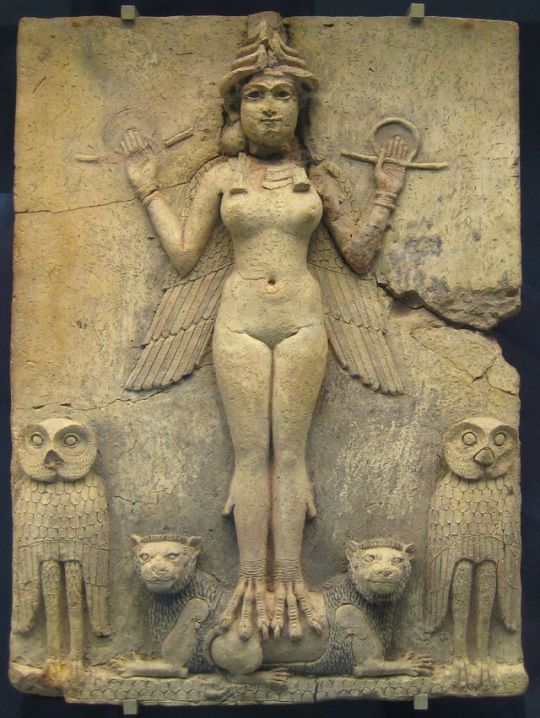



King Cyrus the Great and the Gyndes River
History is old, and has many interesting storys. Let us recount one here. This is the telling of how king Cyrus the Great of Persia in 559 B.C.E. redirected an entire river on his way to capture the ancient city of Babylon.
"When Cyrus was advancing to Babylon, he came to the river Gyndes, which, having its source in the land of the Matienians, flows through the land of the Dardaneans and empties into the Tigris..... Now to cross the River Gyndes requires boats, and when one of Cyrus' sacred white horses audaciously stepped into the river and tried to cross it, the river's current swept him underwater and carried him off. Cyrus was extremely angry at the river for its insolence and threatened that he would weaken it so much that in the future, women would be able to cross it easily without without ever getting their knees wet. Having made this threat, he postponed his expedition against Babylon and divided his army into two units, one for each side of the river. Then, surveying with a rope, he marked out the ground for 180 channels on each side of the Gyndes and leading from it in every direction. Because his labor force was large, this work was finally accomplished, but not until they had spent the whole summer there working it."
Where is the Gyndes River?
1. Cyrus had a huge army with him. The amount of land that needed to be covered is substantial and the amount of raw physical power needed to move the earth is mind numbing.
2. Cyrus' army was organized. Large engineering projects similar to this require people to know where to be and when. Also, the "surveying with rope" phrase implies that there might have been military engineers accompanying Cyrus. This shows a level of military sophistication that is impressive for a time so long ago.
But,
What does this mean? It seems outlandish to believe that Cyrus forced his entire army to did canals in hostile country for an entire summer while he was still at war with the inhabitants, all for a drowned horse. His army could get across the river, and if so why make the canals. Perhaps, Cyrus was just trying to intimidate the surrounding people to surrender to him through his ability to get things down, or maybe he made a deal with the local inhabitants to create all these channels for farming so that they would accept his rule. All in All, an old interesting and murky story.
.....
The Diyala River, is a river and tributary of the Tigris. It is formed by the confluence of Sirwanriver and Tanjero river in Darbandikhan Dam in the Sulaymaniyah Governorate of Northern Iraq. It covers a total distance of 445 km (277 mi).
It rises near Hamadan, in the Zagros Mountains of Iran. It then descends through the mountains, where for some 32 km it forms the border between the two countries. It finally feeds into the Tigris below Baghdad. Navigation of the upper reaches of the Diyala is not possible because of its narrow defiles, but the river's valley provides an important trade route between Iran and Iraq.
The river flows southwest of the Hamrin Mountains.
Its Aramaic origin is "Δέλαζ","Diyalas" and in Kurdish it is called "Sirwan", meaning 'roaring sea' or 'shouting river'. In early Islamic period, the lower course of the river formed part of the Nahrawan Canal. The Diyala Governorate in Iraq is named after the river.
Junction of the Bil And Sirwan Riv
The river is mentioned in Herodotus' Histories under the name Gyndes, where it is stated that the king Cyrus the Greatdispersed it by digging 360 channels as punishment after a sacred white horse perished there. The river returned to its former proportions after the channels disappeared under the sand.
The Battle of Diyala River took place in 693 BC between the forces of the Assyrian empire and the Elamites of southern Iran.
In March 1917 the British Empire defeated the Ottoman Empire at the confluence with the Tigris, leading to the Fall of Baghdad, part of the Mesopotamian Campaign of World War I.
Archaeology
This area flourished already during the Jemdet Nasr and Early Dynastic periods, through to the Akkadian period. During the Larsa period, Eshnunna especially became prominent.
Major excavations were done in the lower Diyala river basin in the 1930s. They were conducted by the University of Chicago Oriental Institute (1930-1937) and by the University of Pennsylvania (1938-1939). The sites such as Tell Agrab, Tell Asmar (ancient Eshnunna), Ishchali (ancient Neribtum), and Khafaje (ancient Tutub) were excavated.
In Tell Asmar, the Tell Asmar Hoard is particularly notable. Twelve remarkable statues were found belonging to the Early Dynastic period (2900 BC-2350 BC).
At that time, the Diyala was relatively unexplored compared to southern and northern Mesopotamia. But looting of sites was already underway. As the result, the professional excavations were launched.
Archaeologists James Breasted and Henri Frankfort were leading these projects.
These excavations provided very comprehensive data on Mesopotamian archaeology and chronology. They covered the time between the late Uruk period and the end of the Old Babylonian period (3000-1700 BC).
Subsequently, nine detailed monographs were published, but most of the objects, numbering 12,000, remained unpublished. Launched in 1992, the Diyala Database Project has been publishing a lot of this material.[2]
Other scholars who worked there were Thorkild Jacobsen as epigrapher, Seton Lloyd, and Pinhas Delougaz.[3]
More recently, the Diyala region was also explored intensively as part of the Hamrin DamSalvage Project.[4]
The following sites were excavated from 1977 to 1981: Tell Yelkhi, Tell Hassan, Tell Abu Husaini, Tell Kesaran, Tell Harbud, Tell al-Sarah, and Tell Mahmud.[5]
Scarlet Ware
A type of pottery known as 'Scarlet Ware', a brightly coloured pottery with pictorial representations, was typical of sites along the Diyala River.[6] It developed around 2800 BC, and is related to the Jemdet Nasr ware in central Mesopotamia of the same period. The red colour was achieved predominantly by using haematite paint.
Scarlet Ware is typical of Early Dynastic I and II periods.[7] Along the Diyala is located one of the most important trade routes linking south Mesopotamia with the Iranian plateau. Thus, Scarlet ware was also popular in Pusht-i Kuh, Luristan, and it was traded to Susa during Susa II period.
Dams
In Iran the Daryan Dam is currently under construction near Daryan in Kermanshah Province. The purpose of the dam is to divert a significant portion of the river to Southwestern Iran for irrigation through the 48 km (30 mi) long Nosoud Water Conveyance Tunnel and to produce hydroelectric power.[8][9] In Iraq, the river first reaches the Darbandikhan Dam which generates hydroelectric power and stores water for irrigation. It then flows down to the Hemrin Dam for similar purposes. In the lower Diyala Valley near Baghdad the river is controlled by the Diyala Weir which controls floods and irrigates the area northeast of Baghdad.
0 notes
Text
14Thus said the Lord,
Your Redeemer, the Holy One of Israel:
For your sake I send to Babylon;
I will bring down all [her] bars,
And the Chaldeans shall raise their voice in lamentation. Isaiah 43/14 Tanakh JPS 1985.
25It is I, I who—for My own sake—
Wipe your transgressions away
And remember your sins no more. Isaiah 43/25 Tanakh JPS 1985.
Thus said the Lord, your Lord,
Your God who champions His people:
Herewith I take from your hand
The cup of reeling,
The bowl, the cup of My wrath;
You shall never drink it again.
I will put it in the hands of your tormentors,
Who have commanded you,
“Get down, that we may walk over you”—
So that you made your back like the ground,
Like a street for passersby. Isaiah 51/22-23 Tanakh JPS 1985.
The prophet Isaiah’s name, meaning “God is salvation,” serves as the title of the book.Isaiah son of Amoz is called to prophesy in the year that King Uzziah dies (ca. 740 b.c.e. and continues his work at least until 701 b.c.e Of his personal history we know little. His wife, “the prophetess,” and his sons, whose names bear witness to his prophetic announcements, are mentioned. He has access to the kings of his time (Uzziah, Jotham, Ahaz, and Hezekiah).
From: Tanakh JPS (1985) Summary “Isaiah” at http://taggedtanakh.org/Chapter/Index/english-Gen-1
When the city of Babylon rose up and took control of Mesopotamia from the Assyrians in 626 BC, the era of the New Babylonians, or Chaldeans, began. Led by their chief Nabopolassar, the Babylonians never again allowed the northern city-states of Mesopotamia have their independence. When Nabopolassar was succeeded by his son, Nebuchadnezzar II, he continued to ensure that the borders of Mesopotamia were safe from outside groups and even expanded the empire to include Phoenicians and Judah. Nebuchadnezzar II held captive the two succeeding kings of Judah, Jehoiachin and Zedekiah, and scattered the people of Judah throughout the empire’s vast lands. With over ten thousand Jewish people from the upper class and crafts trades being removed, this marked the official beginning of the Jewish Exile.
Under the direction of Nebuchadnezzar II, the city of Babylon was rebuilt to become one of the most magnificent cities in the entire Middle East and Mediterranean region. There did, however, remain many cities that were still loyal to the Assyrians. The Babylonian empire was constantly challenged by internal threats. After only five successions, the Chaldeans fell when an Assyrian loyalist king, Nabonidus who angered many of the Babylonian priests by replacing the Assyrian moon-god, Sin, above the Babylonian’s main god, Marduk in 555 BC. The Chaldeans, sensing the internal threat, called on the Persian Cyrus the Conqueror to take over, thus ending the Semitic rule of Mesopotamia around 539 BC. Cyrus soon moved the center of the Middle Eastern world to his capital of Susa. The power would shift again when the Greeks took control of the land and again when the Romans defeated the Greeks. For over two hundred years, Babylon stood as the hub of the Middle East, only to fall to the new wave of power and the return of the Indo-Europeans.
From: The Chaldeans (New Babylonians) http://www.sussexvt.k12.de.us/science/the%20history%20of%20the%20world%20secrets%20of%20the%20ancient%20past/Mesopotamia/The%20Chaldeans.htm
“In its widest acceptation, Chaldea is the name of the whole of Babylonia, owing to the fact that the Chaldeans had given more than one king to the country. In the strict sense, however, their domain was the tract at the Northwest end of the Persian Gulf, which was often called by the Assyro-Babylonians mat Tamtim, “the Land of the Sea,” a province of unknown extent. When these tribes migrated into Babylonia is uncertain, as is also their original home; but as they are closely related to the Arameans, it is possible that their first settlements lay in the neighborhood of the Aramean states bordering on the Holy Land.”
From: bibleatlas.org/chaldea.htm
23“Thus said King Cyrus of Persia: The Lord God of Heaven has given me all the kingdoms of the earth, and has charged me with building Him a House in Jerusalem, which is in Judah. Any one of you of all His people, the Lord his God be with him and let him go up.” 2Chronicles 36/2 Tanakh JPS 1985.
27See, a time is coming—declares the Lord—when I will sow the House of Israel and the House of Judah with seed of men and seed of cattle; 28and just as I was watchful over them to uproot and to pull down, to overthrow and to destroy and to bring disaster, so I will be watchful over them to build and to plant—declares the Lord. 29In those days, they shall no longer say, “Parents have eaten sour grapes and children’s teeth are blunted.” 30But every one shall die for his own sins: whosoever eats sour grapes, his teeth shall be blunted. Jeremiah 31/27-30 Tanakh JPS 1985.
31See, a time is coming—declares the Lord—when I will make a new covenant with the House of Israel and the House of Judah. 32It will not be like the covenant I made with their fathers, when I took them by the hand to lead them out of the land of Egypt, a covenant which they broke, though I espoused them—declares the Lord. 33But such is the covenant I will make with the House of Israel after these days—declares the Lord: I will put My Teaching into their inmost being and inscribe it upon their hearts. Then I will be their God, and they shall be My people. 34No longer will they need to teach one another and say to one another, “Heed the Lord“; for all of them, from the least of them to the greatest, shall heed Me—declares the Lord.
For I will forgive their iniquities, And remember their sins no more. Jeremiah 31/31-34 Tanakh JPS 1985.
38See, a time is coming—declares the Lord—when the city shall be rebuilt for the Lord from the Tower of Hananel to the Corner Gate; 39and the measuring line shall go straight out to the Gareb Hill, and then turn toward Goah. 40And the entire Valley of the Corpses and Ashes, and all the fields as far as the Wadi Kidron, and the corner of the Horse Gate on the east, shall be holy to the Lord. They shall never again be uprooted or overthrown. Jeremiah 31/38-40 Tanakh JPS 1985.
1Behold, I am sending My messenger to clear the way before Me, and the Lord whom you seek shall come to His Temple suddenly. As for the angel of the covenant that you desire, he is already coming. 2But who can endure the day of his coming, and who can hold out when he appears? For he is like a smelter’s fire and like fuller’s lye. Malachi 3/1-2 Tanakh JPS 1985.
22Be mindful of the Teaching of My servant Moses, whom I charged at Horeb with laws and rules for all Israel. 23Lo, I will send the prophet Elijah to you before the coming of the awesome, fearful day of the Lord. 24He shall reconcile parents with children and children with their parents, so that, when I come, I do not strike the whole land with utter destruction. Lo, I will send the prophet Elijah to you before the coming of the awesome, fearful day of the Lord. Malachi 3/22-24 Tanakh JPS 1985.
10But the Lord chose to crush him by disease, That, if he made himself an offering for guilt, He might see offspring and have long life, And that through him the Lord’s purpose might prosper. 11Out of his anguish he shall see it; He shall enjoy it to the full through his devotion. “My righteous servant makes the many righteous, It is their punishment that he bears; Isaiah 53/10-11 Tanakh JPS 1985.
Commentary:
In Jeremiah 31/34 G-d tells the Jewish people that He will forgive their iniquities and remember their sins no more in a time to come.
G-d tells the Jewish people when that time is. He begins in Jeremiah 31/27-28 with:
“See, a time is coming—declares the Lord—when I will sow the House of Israel and the House of Judah with seed of men and seed of cattle; and just as I was watchful over them to uproot and to pull down, to overthrow and to destroy and to bring disaster, so I will be watchful over them to build and to plant—declares the Lord.”
This is when the Jewish people return to the promised land and make it bloom again. The first time this could have happened would have been when the Assyrian/Babylon exiles returned except that the northern kingdom was inhabited by imported gentiles and the exiles had already been forgiven of all of their sins when the Chaldeans/Babylonians were defeated by Cyrus of Persia.
In Isaiah 43/14 G-d declares as the redeemer of Israel long before the Assyrians were defeated by the New Babylonians, or Chaldeans and the final defeat and deportation of the southern kingdom of Judah that:
“For your sake I send to Babylon; I will bring down all [her] bars, And the Chaldeans shall raise their voice in lamentation”
Which is accomplished by G-d raising up Cyrus of Persia as G-d’s anointed king (the gentile HaMoshiach) who defeats the Chaldeans/Babylonians and decrees that all of Israel in the Persian Empire that includes all of the lands of Assyro/Babylon can return to Jerusalem to build the Temple of G-d.
And G-d makes sure they are a Holy seed for the task in Isaiah 43/25:
“It is I, I who—for My own sake—Wipe your transgressions away And remember your sins no more.”
And history reveals that it was not the “time to come” because of the destruction of Jerusalem and exile and dispersal of the Jewish people by Rome.
G-d says in Jeremiah 43/38 that the time to come is:
“when the city shall be rebuilt for the Lord from the Tower of Hananel to the Corner Gate; 39and the measuring line shall go straight out to the Gareb Hill, and then turn toward Goah. 40And the entire Valley of the Corpses and Ashes, and all the fields as far as the Wadi Kidron, and the corner of the Horse Gate on the east, shall be holy to the Lord. They shall never again be uprooted or overthrown.”
And this is Jerusalem today. The time to come in Jeremiah 31/31-34 when G-d declares He will make a new covenant with the House of Israel not like the covenant He made with them out of Egypt which they broke but He married them anyway (and G-d does not divorce):
“But such is the covenant I will make with the House of Israel after these days—declares the Lord: I will put My Teaching into their inmost being and inscribe it upon their hearts. Then I will be their God, and they shall be My people. 34No longer will they need to teach one another and say to one another, “Heed the Lord“; for all of them, from the least of them to the greatest, shall heed Me—declares the Lord.
For I will forgive their iniquities, And remember their sins no more.”
The covenant for a time to come is “I will put My Teaching into their inmost being and inscribe it upon their hearts. Then I will be their G-d, and they shall be My people.”
“For I will forgive their iniquities, And remember their sins no more.”
G-d does not say how He will change the knowledge of the Jewish people of the Torah and how it should be interpreted by all Jews or how He will change the emotions and thinking of His people towards Him. There are a lot of hard feelings between many of the Jewish people and G-d.
G-d says that His forgiving their iniquities and remembering their sins no more will accomplish this putting of His Teaching into their inmost being and inscribing it upon their hearts.
If G-d does not use His power to change the knowledge and hearts of the Jewish people in His Teachings and towards Him the forgiveness of sins alone will not accomplish this.
The Jewish people and all of the different ways of interpreting the Torah by different branches of Judaism are to diverse and opinionated. Rarely is there an accord and meeting of the minds by the Sages of the Talmud, the Rabbi’s today and the people in general.
G-d has never changed the will of men and placed knowledge into their minds or changed their emotions and feelings towards Him in His power. He spent forty years in the desert with Moses and the Israelites changing the minds and hearts of the Hebrews with His Teachings He gave to Moses at Horeb.
And He became their G-d and they became His people at Horeb (Sinai). Just like the covenant to be made in a time to come:
“I will put My Teaching into their inmost being and inscribe it upon their hearts. Then I will be their G-d, and they shall be My people.”
So in the desert for forty years with Moses as the messenger of the Teachings of G-d and all the experiences of the people when G-d dwelt among the tents of the Israelites is what this means:
“I will put My Teaching into their inmost being and inscribe it upon their hearts.”
It is G-d’s way to use men for His purposes and in Isaiah 53/10 G-d crushes a man with disease so that if he made himself an offering for guilt he might see offspring and have long life and that through him the Lord’s purpose might prosper. This purpose which might prosper is not stated.
And in Malachi 3/22-24 the purpose of G-d which might prosper is revealed:
“Be mindful of the Teaching of My servant Moses, whom I charged at Horeb with laws and rules for all Israel. Lo, I will send the prophet Elijah to you before the coming of the awesome, fearful day of the Lord. He shall reconcile parents with children and children with their parents, so that, when I come, I do not strike the whole land with utter destruction.”
If Elijah does not reconcile parents with children and children with their parents so that they are all mindful of the Teachings of Moses G-d will strike the whole land with utter destruction.
This is the manner in which G-d tells the readers of the Jewish Bible that G-d’s righteous servant of Isaiah 53 is Elijah and his arrival when the promised land blooms again and Jerusalem has been rebuilt as it is today is the “time to come” of His covenant of sin forgiveness of the Jewish people.
Elijah comes with “the angel of the covenant that you desire” which is the covenant of sin forgiveness with the Teachings G-d gave to Moses at Horeb to change the minds and hearts of the Jewish people and reconcile families one member to the other to the practice of Judaism. Just like Moses. Elijah is the prophet like Moses and G-d’s righteous servant of Isaiah 53.
And the angel of the covenant is the angel of G-d’s Presence who is the person of the spirit of the Holy G-d that alights upon Elijah to bring the covenant of sin forgiveness. Elijah is the twig of the stump of Jesse that the spirit of G-d alights upon in Isaiah 11/1-2.
This is G-d’s covenant for a time to come. The Jewish people have returned to the promised land and made it bloom again and rebuilt Jerusalem. All they have to do now is to be mindful of His Teachings and heed and revere His name.
Then He will be their G-d and they will be his people, again. All is forgiven. And G-d will treat the Jewish people graciously and return to Jerusalem to have His Temple rebuilt.
The covenant is established and is eternal.
And in Isaiah 51/22-23 G-d passes the bowl, the cup of His wrath and puts it in the hands of “your tormentors, Who have commanded you, “Get down, that we may walk over you”—So that you made your back like the ground, Like a street for passersby.
And after the awesome, fearful day of the L-rd the Jewish people will never be overthrown and uprooted again.
The Covenant of Sin Forgiveness For a Time to Come 14Thus said the Lord, Your Redeemer, the Holy One of Israel: For your sake I send to Babylon;
0 notes
Text
Avalanche Kills 3 Ski Mountaineers Near Mount Chaberton In Italy
Avalanche Kills 3 Ski Mountaineers Near Mount Chaberton In Italy
Valley Susa, Italy – On Friday, February 17, 2017 three ski mountaineers were killed in an avalanche while ski touring on Mount Chaberton in the Upper Susa Valley in Italy near the border between France and Italy. The bodies were located the next day on the Italian side.
Avalanche | AMJ File Library
On Friday morning the group had parked at Montgenevre in France and set off on a ski tour towards…
View On WordPress
0 notes
Text
Pray for: The world Reading: Nehemiah 1-4 Nehemiah’s Prayer 1 The words of Nehemiah son of Hakaliah: In the month of Kislev in the twentieth year, while I was in the citadel of Susa, 2 Hanani, one of my brothers, came from Judah with some other men, and I questioned them about the Jewish remnantthat had survived the exile, and also about Jerusalem. 3 They said to me, “Those who survived the exile and are back in the province are in great trouble and disgrace. The wall of Jerusalem is broken down, and its gates have been burned with fire.” 4 When I heard these things, I sat down and wept. For some days I mourned and fasted and prayed before the God of heaven. 5 Then I said: “Lord, the God of heaven, the great and awesome God, who keeps his covenant of lovewith those who love him and keep his commandments, 6 let your ear be attentive and your eyes open to hear the prayer your servant is praying before you day and night for your servants, the people of Israel. I confess the sins we Israelites, including myself and my father’s family, have committed against you.7 We have acted very wickedly toward you. We have not obeyed the commands, decrees and laws you gave your servant Moses. 8 “Remember the instruction you gave your servant Moses, saying, ‘If you are unfaithful, I will scatter you among the nations, 9 but if you return to me and obey my commands, then even if your exiled people are at the farthest horizon, I will gather them from there and bring them to the place I have chosen as a dwelling for my Name.’ 10 “They are your servants and your people, whom you redeemed by your great strength and your mighty hand. 11 Lord, let your ear be attentive to the prayer of this your servant and to the prayer of your servants who delight in revering your name. Give your servant success today by granting him favor in the presence of this man.” I was cupbearer to the king. Artaxerxes Sends Nehemiah to Jerusalem 2 In the month of Nisan in the twentieth year of King Artaxerxes, when wine was brought for him, I took the wine and gave it to the king. I had not been sad in his presence before, 2 so the king asked me, “Why does your face look so sad when you are not ill? This can be nothing but sadness of heart.” I was very much afraid, 3 but I said to the king, “May the king live forever! Why should my face not look sad when the city where my ancestors are buried lies in ruins, and its gates have been destroyed by fire?” 4 The king said to me, “What is it you want?” Then I prayed to the God of heaven, 5 and I answered the king, “If it pleases the king and if your servant has found favor in his sight, let him send me to the city in Judah where my ancestors are buried so that I can rebuild it.” 6 Then the king, with the queen sitting beside him, asked me, “How long will your journey take, and when will you get back?” It pleased the king to send me; so I set a time. 7 I also said to him, “If it pleases the king, may I have letters to the governors of Trans-Euphrates,so that they will provide me safe-conduct until I arrive in Judah? 8 And may I have a letter to Asaph, keeper of the royal park, so he will give me timber to make beams for the gates of the citadel by the temple and for the city wall and for the residence I will occupy?” And because the gracious hand of my God was on me, the king granted my requests. 9 So I went to the governors of Trans-Euphrates and gave them the king’s letters. The king had also sent army officers and cavalry with me. 10 When Sanballat the Horonite and Tobiah the Ammonite official heard about this, they were very much disturbed that someone had come to promote the welfare of the Israelites. Nehemiah Inspects Jerusalem’s Walls 11 I went to Jerusalem, and after staying there three days 12 I set out during the night with a few others. I had not told anyone what my God had put in my heart to do for Jerusalem. There were no mounts with me except the one I was riding on. 13 By night I went out through the Valley Gatetoward the Jackal[a] Well and the Dung Gate,examining the walls of Jerusalem, which had been broken down, and its gates, which had been destroyed by fire. 14 Then I moved on toward the Fountain Gate and the King’s Pool,but there was not enough room for my mount to get through; 15 so I went up the valley by night, examining the wall. Finally, I turned back and reentered through the Valley Gate. 16 The officials did not know where I had gone or what I was doing, because as yet I had said nothing to the Jews or the priests or nobles or officials or any others who would be doing the work. 17 Then I said to them, “You see the trouble we are in: Jerusalem lies in ruins, and its gates have been burned with fire. Come, let us rebuild the wall of Jerusalem, and we will no longer be in disgrace.” 18 I also told them about the gracious hand of my God on me and what the king had said to me. They replied, “Let us start rebuilding.” So they began this good work. 19 But when Sanballat the Horonite, Tobiah the Ammonite official and Geshem the Arab heard about it, they mocked and ridiculed us. “What is this you are doing?” they asked. “Are you rebelling against the king?” 20 I answered them by saying, “The God of heaven will give us success. We his servants will start rebuilding, but as for you, you have no sharein Jerusalem or any claim or historic right to it.” Builders of the Wall 3 Eliashib the high priest and his fellow priests went to work and rebuilt the Sheep Gate. They dedicated it and set its doors in place, building as far as the Tower of the Hundred, which they dedicated, and as far as the Tower of Hananel.2 The men of Jericho built the adjoining section, and Zakkur son of Imri built next to them. 3 The Fish Gate was rebuilt by the sons of Hassenaah. They laid its beams and put its doors and bolts and bars in place. 4 Meremoth son of Uriah, the son of Hakkoz, repaired the next section. Next to him Meshullam son of Berekiah, the son of Meshezabel, made repairs, and next to him Zadok son of Baana also made repairs. 5 The next section was repaired by the men of Tekoa,but their nobles would not put their shoulders to the work under their supervisors.[b] 6 The Jeshanah[c] Gate was repaired by Joiada son of Paseah and Meshullam son of Besodeiah. They laid its beams and put its doors with their bolts and bars in place. 7 Next to them, repairs were made by men from Gibeon and Mizpah—Melatiah of Gibeon and Jadon of Meronoth—places under the authority of the governor of Trans-Euphrates. 8 Uzziel son of Harhaiah, one of the goldsmiths, repaired the next section; and Hananiah, one of the perfume-makers, made repairs next to that. They restored Jerusalem as far as the Broad Wall. 9 Rephaiah son of Hur, ruler of a half-district of Jerusalem, repaired the next section. 10 Adjoining this, Jedaiah son of Harumaph made repairs opposite his house, and Hattush son of Hashabneiah made repairs next to him. 11 Malkijah son of Harim and Hasshub son of Pahath-Moab repaired another section and the Tower of the Ovens. 12 Shallum son of Hallohesh, ruler of a half-district of Jerusalem, repaired the next section with the help of his daughters. 13 The Valley Gate was repaired by Hanun and the residents of Zanoah. They rebuilt it and put its doors with their bolts and bars in place. They also repaired a thousand cubits[d] of the wall as far as the Dung Gate. 14 The Dung Gate was repaired by Malkijah son of Rekab, ruler of the district of Beth Hakkerem.He rebuilt it and put its doors with their bolts and bars in place. 15 The Fountain Gate was repaired by Shallun son of Kol-Hozeh, ruler of the district of Mizpah. He rebuilt it, roofing it over and putting its doors and bolts and bars in place. He also repaired the wall of the Pool of Siloam,[e] by the King’s Garden, as far as the steps going down from the City of David. 16 Beyond him, Nehemiah son of Azbuk, ruler of a half-district of Beth Zur, made repairs up to a point opposite the tombs[f] of David, as far as the artificial pool and the House of the Heroes. 17 Next to him, the repairs were made by the Levites under Rehum son of Bani. Beside him, Hashabiah, ruler of half the district of Keilah,carried out repairs for his district. 18 Next to him, the repairs were made by their fellow Levites under Binnui[g] son of Henadad, ruler of the other half-district of Keilah. 19 Next to him, Ezer son of Jeshua, ruler of Mizpah, repaired another section, from a point facing the ascent to the armory as far as the angle of the wall. 20 Next to him, Baruch son of Zabbai zealously repaired another section, from the angle to the entrance of the house of Eliashib the high priest. 21 Next to him, Meremoth son of Uriah, the son of Hakkoz, repaired another section, from the entrance of Eliashib’s house to the end of it. 22 The repairs next to him were made by the priests from the surrounding region. 23 Beyond them, Benjamin and Hasshub made repairs in front of their house; and next to them, Azariah son of Maaseiah, the son of Ananiah, made repairs beside his house. 24 Next to him, Binnuison of Henadad repaired another section, from Azariah’s house to the angle and the corner,25 and Palal son of Uzai worked opposite the angle and the tower projecting from the upper palace near the court of the guard. Next to him, Pedaiah son of Parosh 26 and the temple servants living on the hill of Ophel made repairs up to a point opposite the Water Gate toward the east and the projecting tower. 27 Next to them, the men of Tekoa repaired another section, from the great projecting tower to the wall of Ophel. 28 Above the Horse Gate, the priests made repairs, each in front of his own house. 29 Next to them, Zadok son of Immer made repairs opposite his house. Next to him, Shemaiah son of Shekaniah, the guard at the East Gate, made repairs. 30 Next to him, Hananiah son of Shelemiah, and Hanun, the sixth son of Zalaph, repaired another section. Next to them, Meshullam son of Berekiah made repairs opposite his living quarters. 31 Next to him, Malkijah, one of the goldsmiths, made repairs as far as the house of the temple servants and the merchants, opposite the Inspection Gate, and as far as the room above the corner; 32 and between the room above the corner and the Sheep Gatethe goldsmiths and merchants made repairs. Opposition to the Rebuilding 4 [h]When Sanballat heard that we were rebuilding the wall, he became angry and was greatly incensed. He ridiculed the Jews, 2 and in the presence of his associates and the army of Samaria, he said, “What are those feeble Jews doing? Will they restore their wall? Will they offer sacrifices? Will they finish in a day? Can they bring the stones back to life from those heaps of rubble—burned as they are?” 3 Tobiah the Ammonite, who was at his side, said, “What they are building—even a fox climbing up on it would break down their wall of stones!” 4 Hear us, our God, for we are despised. Turn their insults back on their own heads. Give them over as plunder in a land of captivity. 5 Do not cover up their guilt or blot out their sins from your sight, for they have thrown insults in the face of[i]the builders. 6 So we rebuilt the wall till all of it reached half its height, for the people worked with all their heart. 7 But when Sanballat, Tobiah, the Arabs, the Ammonites and the people of Ashdod heard that the repairs to Jerusalem’s walls had gone ahead and that the gaps were being closed, they were very angry. 8 They all plotted together to come and fight against Jerusalem and stir up trouble against it. 9 But we prayed to our God and posted a guard day and night to meet this threat. 10 Meanwhile, the people in Judah said, “The strength of the laborers is giving out, and there is so much rubble that we cannot rebuild the wall.” 11 Also our enemies said, “Before they know it or see us, we will be right there among them and will kill them and put an end to the work.” 12 Then the Jews who lived near them came and told us ten times over, “Wherever you turn, they will attack us.” 13 Therefore I stationed some of the people behind the lowest points of the wall at the exposed places, posting them by families, with their swords, spears and bows. 14 After I looked things over, I stood up and said to the nobles, the officials and the rest of the people, “Don’t be afraid of them. Remember the Lord, who is great and awesome, and fight for your families, your sons and your daughters, your wives and your homes.” 15 When our enemies heard that we were aware of their plot and that God had frustrated it, we all returned to the wall, each to our own work. 16 From that day on, half of my men did the work, while the other half were equipped with spears, shields, bows and armor. The officers posted themselves behind all the people of Judah 17 who were building the wall. Those who carried materials did their work with one hand and held a weapon in the other, 18 and each of the builders wore his sword at his side as he worked. But the man who sounded the trumpet stayed with me. 19 Then I said to the nobles, the officials and the rest of the people, “The work is extensive and spread out, and we are widely separated from each other along the wall. 20 Wherever you hear the sound of the trumpet, join us there. Our God will fight for us!” 21 So we continued the work with half the men holding spears, from the first light of dawn till the stars came out. 22 At that time I also said to the people, “Have every man and his helper stay inside Jerusalem at night, so they can serve us as guards by night and as workers by day.”23 Neither I nor my brothers nor my men nor the guards with me took off our clothes; each had his weapon, even when he went for water.[j]
0 notes
Photo
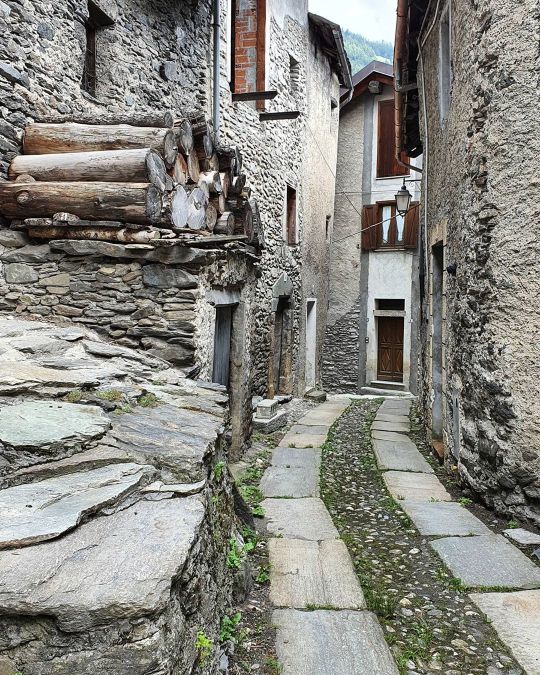
Samsung Galaxy Note 10+ Taken on 28/06/2020. Located in the Upper Susa Valley is Salbertrand, a medieval mountain village that is home to the Gran Bosco Natural Park — a favourite spot for people who want to get away from the constant noise and heavy traffic in Turin and are instead in search of peace and quiet in the woods. The village itself shouldn't be skipped, though, as it includes two churches containing splendid 16th-century frescoes: the Parish Church of San Giovanni Battista and the Chapel of San Cristoforo. The latter is in a small hamlet called Oulme, but it's technically part of Salbertrand, and also goes by the name of 'La Gleisëtta' in local dialect. In fact, all the streets I saw were signposted in this dialect, which isn't evident in the Lower Susa Valley. If you know French, you'd be able to understand some of these signs like 'Rüà du Fū' ('Via del Forno' in Italian and 'Oven Street' in English). I didn't hear this dialect spoken, however, so the street signs are perhaps a way to keep it alive and remind locals of the village's long history. Swipe to the second photo to see another important monument in Salbertrand called 'Hotel Dieu' that lodged pilgrims and travellers during the 15th Century. Its frescoes, which date back to the same century, were carefully restored as recently as 2016 and are impressive works of art, including a depiction of Christ dead on the knees of the Virgin Mary. 𝗛𝗼𝘄 𝘁𝗼 𝗴𝗲𝘁 𝘁𝗵𝗲𝗿𝗲: Salbertrand is one of the stops on the Torino–Bardonecchia line. The historical centre is a 5-minute uphill walk from the station on your left; the beginning is marked by the Parish Church of San Giovanni Battista and the end by the Chapel of San Cristoforo. ______________________________________ #valdisusa #ig_turin #piedmont #piemonte_super_pics #piemonteconte #italytour #italia #italy #smartphonepics #ilikeitaly #charmingitaly #italian_places #browsingitaly #treasureitaly #italy_hidden_gems #ig_italia #gf_italy #cnntravel #cntraveler #yallersitalia #yallerspiemonte #ig_piemonte #bestdestinations #beautifulplaces #lovers_italia #loves_madeinitaly #nofilter #italy_illife #travelgrammers #salbertrand (at Salbertrand) https://www.instagram.com/p/CCB9ECTIjj1/?igshid=6jng8cl32h58
#valdisusa#ig_turin#piedmont#piemonte_super_pics#piemonteconte#italytour#italia#italy#smartphonepics#ilikeitaly#charmingitaly#italian_places#browsingitaly#treasureitaly#italy_hidden_gems#ig_italia#gf_italy#cnntravel#cntraveler#yallersitalia#yallerspiemonte#ig_piemonte#bestdestinations#beautifulplaces#lovers_italia#loves_madeinitaly#nofilter#italy_illife#travelgrammers#salbertrand
0 notes
Photo

Canon EOS 250D | 24mm | 1/2500s | f/4 | ISO 100 Taken on 28/06/2020. At the end of the Upper Susa Valley is Bardonecchia. Like Clavier, it's the perfect place for people like me who love walking in the mountains. And, like Clavier, Bardonecchia isn't only aimed at trained excursionists (otherwise, I wouldn't have made the trip!). Rather, it boasts a vast variety of trails for beginners and intermediate-level hikers. This photo wasn't taken on my excursion this morning, though. I actually took it from a little-known viewpoint that consisted of a tower rising above a hill. The tower is called "Tur d'Amun" and is situated just 10 minutes from the old town centre known as 'Borgovecchio'. It was originally built in the middle of the 12th Century for military purposes, and later became a residence for the local lord François de Bardonnèche. Now all that remains is the tower that can't be visited inside, but offers a wonderful panorama of Bardonecchia. 𝗛𝗼𝘄 𝘁𝗼 𝗴𝗲𝘁 𝘁𝗵𝗲𝗿𝗲: Bardonecchia is easily reachable by train on the Torino Porta Nuova–Bardonecchia. Some trains also leave from Torino Porta Susa station. ______________________________________ #ig_turin #bardonecchia #italia #italy #ilikeitaly #estateitaliana #mountainview #mountainsarecalling #mountainlovers #landscape_captures #landscapelovers #igersitalia #yallersitalia #piedmont #thehub_piemonte #piemonteconte #thehub_italia #beautifuldestinations #wonderfulplaces #whatitalyis #welivetoexplore #welltravelled #greentourism #greentravel #trenitalia #italia_inunoscatto #tv_living #prettylittleitaly #lonelyplanet (at Bardonecchia) https://www.instagram.com/p/CB-tI0CoKos/?igshid=7hjdj96qqitd
#ig_turin#bardonecchia#italia#italy#ilikeitaly#estateitaliana#mountainview#mountainsarecalling#mountainlovers#landscape_captures#landscapelovers#igersitalia#yallersitalia#piedmont#thehub_piemonte#piemonteconte#thehub_italia#beautifuldestinations#wonderfulplaces#whatitalyis#welivetoexplore#welltravelled#greentourism#greentravel#trenitalia#italia_inunoscatto#tv_living#prettylittleitaly#lonelyplanet
0 notes
Photo
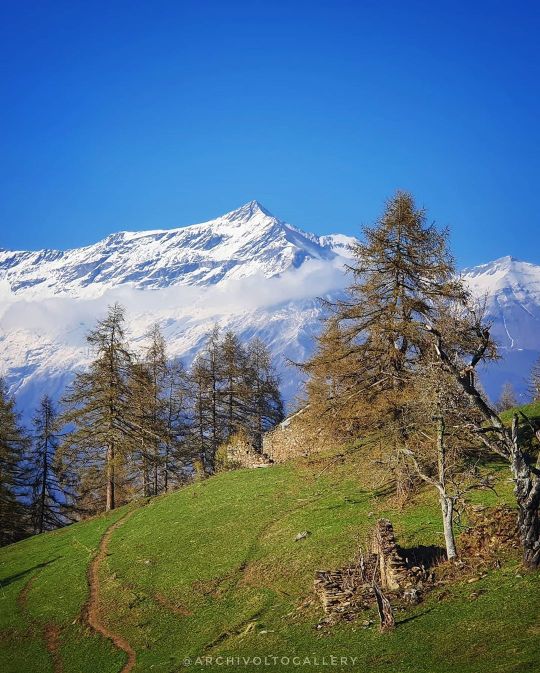
🐤 🇬🇧 Summer and winter seem to have found an agreement .. This is the "Rocciamelone" mount from the woods of the upper Susa valley. The Susa valley offers ideal destinations for excursions of various kinds in the mountain environment, all easily accessible from Susa. Plan your excursion now, ask for information at B&B Archivolto in Susa. 🇮🇹 L'estate e l'inverno sembrano aver trovato un accordo.. Questa è la vista verso il monte Rocciamelone dai boschi dell'alta val Susa. La Val di Susa offre mete ideali per escursioni di vari generi nell'ambiente montano, tutte facilmente raggiungibili da Susa. Organizzate fin d'ora la vostra escursione, chiedete informazioni al B&B Archivolto di Susa !! 〰️〰️〰️〰️〰️〰️〰️〰️〰️〰️〰️〰️〰️〰️ ✈ Made with passion 👉 Follow: @archivoltogallery 🌝 Double Tap 👊👊 if you like it! 🙏 Tag a friend, he needs to see this! 〰️〰️〰️〰️〰️〰️〰️〰️〰️〰️〰️〰️〰️〰️ By the way.. make sure to Visit Susa Valley before you die 😜 .. Susa is at 30 minuts from everywhere in Susa Valley and Archivolto B&B can be your base camp for your adventures or your home away from home! 🏠👍 👉Link in bio👈 .. Have a nice day! .. 🇮🇹 〰️〰️〰️〰️〰️〰️〰️〰️〰️〰️〰️〰️〰️〰️ #archivoltogallery #montagna #valsusa #mountain #rocciamelone #lovemountains #ig_world #primavera #spring #dronefly #rhonealpes #susavalley #alps #welivetoexplore #letsgosomewhere #naturegram #valledisusa #cicloturismo #dronestagram #bosco #environment #outdoor #ig_piemonte #vistadallalto #yallerspiemonte #savoie #piemonte #natureisawesome #vanoise #mauriennisezvous (presso Gran Bosco Di Salbertrand) https://www.instagram.com/p/B_bG5uyAAWo/?igshid=ox34pebearhf
#archivoltogallery#montagna#valsusa#mountain#rocciamelone#lovemountains#ig_world#primavera#spring#dronefly#rhonealpes#susavalley#alps#welivetoexplore#letsgosomewhere#naturegram#valledisusa#cicloturismo#dronestagram#bosco#environment#outdoor#ig_piemonte#vistadallalto#yallerspiemonte#savoie#piemonte#natureisawesome#vanoise#mauriennisezvous
0 notes
Photo

🐤 🇬🇧 Susa, the bell tower of the cathedral of San Giusto in San Giusto square with the Savoy door. The bell tower with its 51 meters height is the highest in the Susa Valley with six internal floors separated by hanging arches illuminated in the upper part by mullioned windows. Outside, at the top, there are various hand-painted decorations. At the bottom, there is a sundial on the side facing Piazza San Giusto. 🇮🇹 Susa, il campanile della cattedrale di San Giusto in piazza San Giusto con la porta Savoia. Il campanile con i suoi 51 metri di altezza è il più alto della Valle di Susa con sei piani interni separati da archetti pensili illuminati nella parte alta da bifore, trifore e quadrifore. All'esterno in alto presenta diverse decorazioni dipinte a mano, mentre verso il basso vi è una meridiana sul lato rivolto in Piazza San Giusto. 〰️〰️〰️〰️〰️〰️〰️〰️〰️〰️〰️〰️〰️〰️ 📱 Made with: Canon EOS 5D 👉 Follow: @archivoltogallery 🌝 Double Tap 👊👊 if you like it! 🙏 Tag a friend that needs to see this! 〰️〰️〰️〰️〰️〰️〰️〰️〰️〰️〰️〰️〰️〰️ 🇮🇹 Have a nice day! .. 〰️〰️〰️〰️〰️〰️〰️〰️〰️〰️〰️〰️〰️〰️ By the way.. make sure to Visit Susa Valley before you die 😜 .. 〰️〰️〰️〰️〰️〰️〰️〰️〰️〰️〰️〰️〰️〰️ Susa is at 30 minuts from everywhere in Susa Valley and Archivolto B&B can be your base camp for your adventures or your home away from home! 🏠👍 👉Link in bio👈 .. 〰️〰️〰️〰️〰️〰️〰️〰️〰️〰️〰️〰️〰️〰️ #archivoltogallery #italiainfoto #valsusa #valdisusa #ilikeitaly #scorci #borghitalia #aerialview #dronepic #streetview #urban #kings_hdr #lucky_hdr #hdr_lovers #architecture #ourstreets #historicalplace #great_captures_hdr #piedmont #best_italiansites #italiainunoscatto #igerspiemonte #piemonteconte #shot_italia #piemonteturismo #volgopiemonte #igerspiemonte #ig_piemonte #piemonte (presso Cattedrale di San Giusto (Susa)) https://www.instagram.com/p/B9CAKr0IlsO/?igshid=16wh5kz5sgt5x
#archivoltogallery#italiainfoto#valsusa#valdisusa#ilikeitaly#scorci#borghitalia#aerialview#dronepic#streetview#urban#kings_hdr#lucky_hdr#hdr_lovers#architecture#ourstreets#historicalplace#great_captures_hdr#piedmont#best_italiansites#italiainunoscatto#igerspiemonte#piemonteconte#shot_italia#piemonteturismo#volgopiemonte#ig_piemonte#piemonte
0 notes
Photo

"Gran Pertus" This civil work, is a tunnel called "Pertus" (pertugio in Italian) made in the upper valley of Susa inside the mountain named "of the 4 teeth", a hydraulic canalization about 500 meters long, about 80-120 cm wide and 1 to 2.5 meters high at 2000 meters high to the north of the Chiomonte village. The excavation, still used from the Middle Ages, is able to derive part of the waters coming from the North side near the Thullie, cooler and more humid because of its exposure that favors more abundant snow and durable and therefore rich in waters coming from the Rio Tornori, to the advantage of the localities of Ramats and Cels, respectively in the municipalities of Chiomonte and Exilles. We are at 10 Km from Gran Pertus, and i can help you to get there 😉 Join Susa valley visit the environment and make your base camp in Susa Archivolto B&B! Book now! Whatsapp me +393496705887 ____________________________________ Make sure to Visit Susa Valley before you die😜 ____________________________________ Double Tap 👊👊 if you like it! and tag a friend that needs to see this! #archivoltogallery #italy #valsusa #valdisusa #piedmont #piemonte #mountaineering #montagna #granpertus #colombanoromean #areeprotettealpicozie #escursionismo #escursione #curiosità #pertus #tunnel #hole #scavo #hiking #rocciascavata #chiomonte #exilles #trekking #foronellaroccia #neverstopexploring #adventurethatislife #ig_piemonte #volgopiemonte #mauriennizedvous #quattrodenti https://www.instagram.com/p/BoI9-C2nVzK/?utm_source=ig_tumblr_share&igshid=17ythtehi6q3z
#archivoltogallery#italy#valsusa#valdisusa#piedmont#piemonte#mountaineering#montagna#granpertus#colombanoromean#areeprotettealpicozie#escursionismo#escursione#curiosità#pertus#tunnel#hole#scavo#hiking#rocciascavata#chiomonte#exilles#trekking#foronellaroccia#neverstopexploring#adventurethatislife#ig_piemonte#volgopiemonte#mauriennizedvous#quattrodenti
0 notes